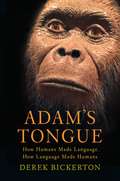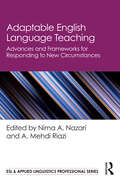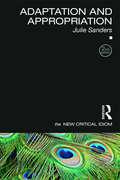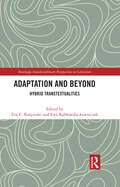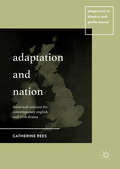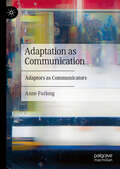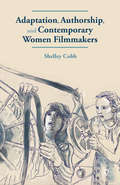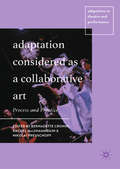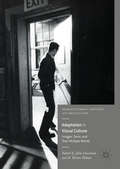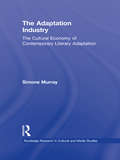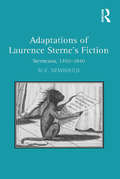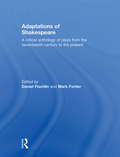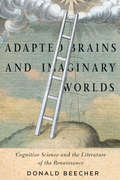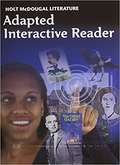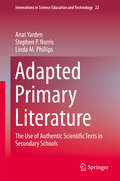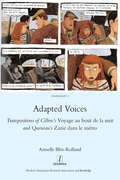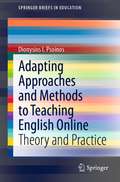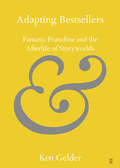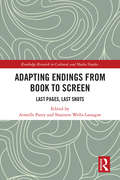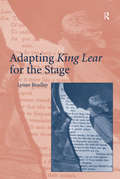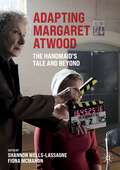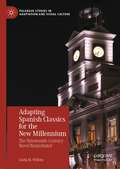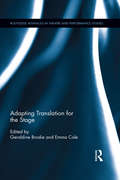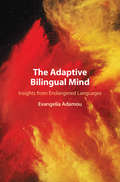- Table View
- List View
Adam's Tongue: How Humans Made Language, How Language Made Humans
by Derek BickertonHow language evolved has been called "the hardest problem in science. " In Adam's Tongue, Derek Bickerton--long a leading authority in this field--shows how and why previous attempts to solve that problem have fallen short. Taking cues from topics as diverse as the foraging strategies of ants, the distribution of large prehistoric herbivores, and the construction of ecological niches, Bickerton produces a dazzling new alternative to the conventional wisdom. Language is unique to humans, but it isn't the only thing that sets us apart from other species--our cognitive powers are qualitatively different. So could there be two separate discontinuities between humans and the rest of nature? No, says Bickerton; he shows how the mere possession of symbolic units--words--automatically opened a new and different cognitive universe, one that yielded novel innovations ranging from barbed arrowheads to the Apollo spacecraft. Written in Bickerton's lucid and irreverent style, this book is the first to thoroughly integrate the story of how language evolved with the story of how humans evolved. Sure to be controversial, it will make indispensable reading both for experts in the field and for every reader who has ever wondered how a species as remarkable as ours could have come into existence. '
Adaptable English Language Teaching: Advances and Frameworks for Responding to New Circumstances (ISSN)
by A. Mehdi Riazi Nima A. NazariIn an age of rapid technological transformation and evolving teaching settings, the ELT community must adapt to the needs of emerging situations and a diverse range of learners. Adaptable English Language Teaching addresses this need by bringing together contributions from renowned scholars around the world with insights on all major areas of English language teaching with an emphasis on adaptability—of teaching method, context, skills, and priorities.Organized around an innovative past-present-future structure, chapters offer methods, strategies, and perspectives that are adaptable to any difficult or under-resourced context. It delves into engaging through online applications, understanding emerging trends in computer-assisted language learning and teaching, and the implementation of virtual classroom and multimodality in ELT.Given its multifaceted focus, this book will provide ELT practitioners, trainers, trainees, and researchers with invaluable insights and research findings to effectively navigate and adapt to emerging circumstances.
Adaptation and Appropriation (The New Critical Idiom)
by Julie SandersFrom the apparently simple adaptation of a text into film, theatre or a new literary work, to the more complex appropriation of style or meaning, it is arguable that all texts are somehow connected to a network of existing texts and art forms. In this new edition Adaptation and Appropriation explores: multiple definitions and practices of adaptation and appropriation the cultural and aesthetic politics behind the impulse to adapt the global and local dimensions of adaptation the impact of new digital technologies on ideas of making, originality and customization diverse ways in which contemporary literature, theatre, television and film adapt, revise and reimagine other works of art the impact on adaptation and appropriation of theoretical movements, including structuralism, post-structuralism, postcolonialism, postmodernism, feminism and gender studies the appropriation across time and across cultures of specific canonical texts, by Shakespeare, Dickens, and others, but also of literary archetypes such as myth or fairy tale. Ranging across genres and harnessing concepts from fields as diverse as musicology and the natural sciences, this volume brings clarity to the complex debates around adaptation and appropriation, offering a much-needed resource for those studying literature, film, media or culture.
Adaptation and Beyond: Hybrid Transtextualities (Routledge Interdisciplinary Perspectives on Literature)
by Eva C. Karpinski Ewa Kębłowska-ŁawniczakThis interdisciplinary collection focuses on recent adaptations, both experimental and popular, that put hybridity, transtextuality, and transmediality at play. It reframes adaptation in terms of the transmedia concept of "world-building," which accurately captures the complexity and multidirectionality of contemporary scattered and ubiquitous practices of adaptation. The Editors argue that the process of moving stories or their elements across different media platforms and repurposing them for new uses results in the production of hybrid transtextualities. The book demonstrate how hybrid textualities augment narrative and literary forms as goals of their world-building, finding unexpected sites of cross-pollination, expansion, and appropriation in spoken-word and dance performance, (auto)biographical comics, advertising, Chinese Kun opera, and popular song lyrics. This yoking of hybridity and transmediality yields not only diversified and often commercialized aesthetic forms but also enables the emergence a unique cultural space in-between, a mezzaterra capable of addressing current political issues and mobilizing broader audiences
Adaptation and Nation: Theatrical Contexts for Contemporary English and Irish Drama (Adaptation in Theatre and Performance)
by Catherine ReesThis book takes a novel approach to theatrical adaptation, focusing not primarily on filmic adaptations but instead on modern drama based on older, classic playtexts. The specific focus of the book is the exploration of the new national setting given to the reworked version. In exploring the way in which contemporary dramatists in England and Ireland represent a different national setting for their reworked adaptation, we can examine the specific social and political context for the new play, unearthing the cultural conditions at the time of the new setting. In examining only plays that consciously relocate the national setting for their new work, we can also explore resonances between the two different national contexts, analysing cultural and political echoes as well as shifts both geographical and temporal.
Adaptation as Communication: Adaptors as Communicators
by Anne FurlongThis book offers a consistent, theoretically grounded, accessible account of adaptation across a range of instances, employing Relevance Theory as its explanatory framework and arguing that every adaptation is an independent communicative act. The author establishes the principles of the study in the first part, introducing and contextualising the theory developed by Sperber and Wilson, before going on in the second part to demonstrate the strength of the approach, and its relevance and utility within adaptation studies and beyond through a wide array of examples. The volume will open up discussion in areas previously underserved by adaptation studies and consider broader implications, such as where we draw the line when we think about 'adaptation'. This book will be of interest to students and scholars in a range of fields including adaptation studies, relevance theory, linguistic pragmatics, stylistics, narratology, intertextuality, literature and film studies.
Adaptation, Authorship, and Contemporary Women Filmmakers
by Shelley CobbA lively discussion of costume dramas to women's films, Shelley Cobb investigates the practice of adaptation in contemporary films made by women. The figure of the woman author comes to the fore as a key site for the representation of women's agency and the authority of the woman filmmaker.
Adaptation Considered as a Collaborative Art: Process and Practice (Adaptation in Theatre and Performance)
by Bernadette Cronin Rachel MagShamhráin Nikolai PreuschoffThis book examines the processes of adaptation across a number of intriguing case studies and media. Turning its attention from the 'what' to the 'how' of adaptation, it serves to re-situate the discourse of adaptation studies, moving away from the hypotheses that used to haunt it, such as fidelity, to questions of how texts, authors and other creative practitioners (always understood as a plurality) engage in dialogue with one another across cultures, media, languages, genders and time itself. With fifteen chapters across fields including fine art and theory, drama and theatre, and television, this interdisciplinary volume considers adaptation across the creative and performance arts, with a single focus on the collaborative.
Adaptation in Visual Culture: Images, Texts, and Their Multiple Worlds (Palgrave Studies in Adaptation and Visual Culture)
by R. Barton Palmer Julie GrossmanThis book offers the first comprehensive discussion of the relationship between Modern Irish Literature and the Irish cinema, with twelve chapters written by experts in the field that deal with principal films, authors, and directors. This survey outlines the influence of screen adaptation of important texts from the national literature on the construction of an Irish cinema, many of whose films because of cultural constraints were produced and exhibited outside the country until very recently. Authors discussed include George Bernard Shaw, Oscar Wilde, Liam O'Flaherty, Christy Brown, Edna O'Brien, James Joyce, and Brian Friel. The films analysed in this volume include THE QUIET MAN, THE INFORMER, MAJOR BARBARA, THE GIRL WITH GREEN EYES, MY LEFT FOOT, THE PICTURE OF DORIAN GRAY, THE SNAPPER, and DANCING AT LUGHNASA. The introduction features a detailed discussion of the cultural and political questions raised by the promotion of forms of national identity by Ireland's literary and cinematic establishments.
The Adaptation Industry: The Cultural Economy of Contemporary Literary Adaptation (Routledge Research in Cultural and Media Studies)
by Simone MurrayAdaptation constitutes the driving force of contemporary culture, with stories adapted across an array of media formats. However, adaptation studies has been concerned almost exclusively with textual analysis, in particular with compare-and-contrast studies of individual novel and film pairings. This has left almost completely unexamined crucial questions of how adaptations come to be made, what are the industries with the greatest stake in making them, and who the decision-makers are in the adaptation process. The Adaptation Industry re-imagines adaptation not as an abstract process, but as a material industry. It presents the adaptation industry as a cultural economy of six interlocking institutions, stakeholders and decision-makers all engaged in the actual business of adapting texts: authors; agents; publishers; book prize committees; scriptwriters; and screen producers and distributors. Through trading in intellectual property rights to cultural works, these six nodal points in the adaptation network are tightly interlinked, with success for one party potentially auguring for success in other spheres. But marked rivalries between these institutional forces also exist, with competition characterizing every aspect of the adaptation process. This book constructs an overdue sociology of contemporary literary adaptation, never losing sight of the material and institutional dimensions of this powerful process.
Adaptations of Laurence Sterne's Fiction: Sterneana, 1760–1840
by Mary-Celine NewbouldExploring how readers received and responded to literary works in the long eighteenth century, M-C. Newbould focuses on the role played by Laurence Sterne’s fiction and its adaptations. Literary adaptation flourished throughout the eighteenth century, encouraging an interactive relationship between writers, readers, and artists when well-known works were transformed into new forms across a variety of media. Laurence Sterne offers a particularly dynamic subject: the immense interest provoked by The Life and Opinions of Tristram Shandy, Gentleman and A Sentimental Journey through France and Italy inspired an unrivalled number and range of adaptations from their initial publication onwards. In placing her examination of Sterneana within the context of its production, Newbould demonstrates how literary adaptation operates across generic and formal boundaries. She breaks new ground by bringing together several potentially disparate aspects of Sterneana belonging to areas of literary studies that include drama, music, travel writing, sentimental fiction and the visual. Her study is a vital resource for Sterne scholars and for readers generally interested in cultural productivity in this period.
Adaptations of Shakespeare: An Anthology of Plays from the 17th Century to the Present
by Daniel Fischlin Mark FortierShakespeare's plays have been adapted or rewritten in various, often surprising, ways since the seventeenth century. This groundbreaking anthology brings together twelve theatrical adaptations of Shakespeares work from around the world and across the centuries. The plays includeThe Woman's Prize or the Tamer Tamed John FletcherThe History of King Lear Nahum TateKing Stephen: A Fragment of a Tragedy John KeatsThe Public (El P(blico) Federico Garcia LorcaThe Resistible Rise of Arturo Ui Bertolt BrechtuMabatha Welcome MsomiMeasure for Measure Charles MarowitzHamletmachine Heiner MüllerLears Daughters The Womens Theatre Group & Elaine FeinsteinDesdemona: A Play About a Handkerchief Paula VogelThis Islands Mine Philip OsmentHarlem Duet Djanet SearsEach play is introduced by a concise, informative introduction with suggestions for further reading. The collection is prefaced by a detailed General Introduction, which offers an invaluable examination of issues related to
Adapted Brains and Imaginary Worlds
by Donald BeecherIn Adapted Brains and Imaginary Worlds, Donald Beecher explores the characteristics and idiosyncrasies of the brain as they affect the study of fiction. He builds upon insights from the cognitive sciences to explain how we actualize imaginary persons, read the clues to their intentional states, assess their representations of selfhood, and empathize with their felt experiences in imaginary environments. He considers how our own faculty of memory, in all its selective particularity and planned oblivion, becomes an increasingly significant dimension of the critical act, and how our own emotions become aggressive readers of literary experience, culminating in states which define the genres of literature. Beecher illustrates his points with examples from major works of the Renaissance period, including Dr Faustus, The Faerie Queene, Measure for Measure, The Yorkshire Tragedy, Menaphon, The Dialogue of Solomon and Marcolphus, and The Moral Philosophy of Doni. In this volume, studies in the science of mind come into their own in explaining the architectures of the brain that shape such emergent properties as empathy, suspense, curiosity, the formation of communities, gossip, rationalization, confabulation, and so much more that pertains to the behaviour of characters, the orientation of readers, and the construction of meaning. Discussing a breadth of topics - from the mysteries of the criminal mind to the psychology of tears - Adapted Brains and Imaginary Worlds is the most comprehensive work available on the study of fictional worlds and their relation to the constitution of the human brain.
Adapted Brains and Imaginary Worlds: Cognitive Science and the Literature of the Renaissance
by Donald BeecherIn Adapted Brains and Imaginary Worlds, Donald Beecher explores the characteristics and idiosyncrasies of the brain as they affect the study of fiction. He builds upon insights from the cognitive sciences to explain how we actualize imaginary persons, read the clues to their intentional states, assess their representations of selfhood, and empathize with their felt experiences in imaginary environments. He considers how our own faculty of memory, in all its selective particularity and planned oblivion, becomes an increasingly significant dimension of the critical act, and how our own emotions become aggressive readers of literary experience, culminating in states which define the genres of literature. Beecher illustrates his points with examples from major works of the Renaissance period, including Dr Faustus, The Faerie Queene, Measure for Measure, The Yorkshire Tragedy, Menaphon, The Dialogue of Solomon and Marcolphus, and The Moral Philosophy of Doni. In this volume, studies in the science of mind come into their own in explaining the architectures of the brain that shape such emergent properties as empathy, suspense, curiosity, the formation of communities, gossip, rationalization, confabulation, and so much more that pertains to the behaviour of characters, the orientation of readers, and the construction of meaning. Discussing a breadth of topics – from the mysteries of the criminal mind to the psychology of tears – Adapted Brains and Imaginary Worlds is the most comprehensive work available on the study of fictional worlds and their relation to the constitution of the human brain.
Adapted Interactive Reader: Grade 11 American Literature (Holt McDougal Literature)
by Holt McDougalHolt McDougal Literature: Adapted Interactive Reader Grade 11 American Literature
Adapted Primary Literature: The Use of Authentic Scientific Texts in Secondary Schools (Innovations in Science Education and Technology #22)
by Stephen P. Norris Linda M. Phillips Anat YardenThis book specifies the foundation for Adapted Primary Literature (APL), a novel text genre that enables the learning and teaching of science using research articles that were adapted to the knowledge level of high-school students. More than 50 years ago, J. J. Schwab suggested that Primary Scientific Articles "afford the most authentic, unretouched specimens of enquiry that we can obtain" and raised for the first time the idea that such articles can be used for "enquiry into enquiry". This book, the first to be published on this topic, presents the realization of this vision and shows how the reading and writing of scientific articles can be used for inquiry learning and teaching. It provides the origins and theory of APL and examines the concept and its importance. It outlines a detailed description of creating and using APL and provides examples for the use of the enactment of APL in classes, as well as descriptions of possible future prospects for the implementation of APL. Altogether, the book lays the foundations for the use of this authentic text genre for the learning and teaching of science in secondary schools.
Adapted Voices
by Armelle Blin-RollandVoyage au bout de la nuit (1932), by Louis-Ferdinand Celine (1894-1961), and Zazie dans le metro (1959), by Raymond Queneau (1903-1976), were two revolutionary novels in their transposition of spoken language into written language. Since their publication they have been adapted into a broad range of media, including illustrated novel, bande dessinee, film, stage performance and recorded reading. What happens to their striking literary voices as they are transposed into media that combine text and image, sound and image, or consist of sound alone? In this study, Armelle Blin-Rolland examines adaptations sparked by these two seminal novels to understand what 'voice' means in each medium, and its importance in the process of adaptation.
Adapting Approaches and Methods to Teaching English Online: Theory and Practice (SpringerBriefs in Education)
by Dionysios I. PsoinosThis book provides a framework for synchronous and asynchronous online language teaching. It elaborates on the key features of an online teaching setting, including the instructional media that are involved in it, their affordances and limitations, and recommends ways to adapt pedagogy to suit the online environment. To this end, the book draws on well-established language teaching methods that have been widely used in the physical classroom and puts them to the test by applying them online. This results in the emergence of an e-clectic approach that enables language teachers to be flexible and intentional in their online classroom-related decisions and combines good practices that cut across the broader methodological spectrum with personal teaching preferences, teaching style, and stakeholders’ specifications always considering the capabilities of the setting and the tools currently available to teachers and learners. The book enables teachers to be critical and reflective of their own online teaching practices and equips them, via analysis of live online language sessions, with the necessary skills to confidently engage with screen layout. It also addresses the prominent issue of adapting teacher and learner identity in the online context, and examines their respective roles in online language sessions in a holistic way, offering guidance and support for the practicing online language teacher.
Adapting Bestsellers: Fantasy, Franchise and the Afterlife of Storyworlds (Elements in Publishing and Book Culture)
by Ken GelderThis Element looks at adaptations of bestselling works of popular fiction to cinema, television, stage, radio, video games and other media platforms. It focuses on 'transmedia storytelling', building its case studies around the genre of modern fantasy: because the elaborate storyworlds produced by writers like J. R. R. Tolkien, J. K. Rowling and George R. R. Martin have readily lent themselves to adaptations across various media platforms. This has also made it possible for media entertainment corporations to invest in them over the long term, enabling the development of franchises through which their storyworlds are presented and marketed in new ways to new audiences.
Adapting Endings from Book to Screen: Last Pages, Last Shots (Routledge Research in Cultural and Media Studies)
by Armelle Parey Shannon Wells-LassagneThis book offers a new perspective on adaptation of books to the screen; by focusing on endings, new light is shed on this key facet of film and television studies. The authors look at a broad range of case studies from different genres, eras, countries and formats to analyse literary and cinematic traditions, technical considerations and ideological issues involved in film and television adaptions. The investigation covers both the ideological implications of changes made in adapting the final pages to the screen, as well as the aesthetic stance taken in modifying (or on the contrary, maintaining) the ending of the source text. By including writings on both film and television adaptations, this book examines the array of possibilities for the closure of an adapted narrative, focusing both on the specificities of film and different television forms (miniseries and ongoing television narratives) and at the same time suggesting the commonalities of these audiovisual forms in their closing moments. Adapting Endings from Book to Screen will be of interest to all scholars working in media studies, film and television studies, and adaptation studies.
Adapting King Lear for the Stage
by Lynne BradleyQuestioning whether the impulse to adapt Shakespeare has changed over time, Lynne Bradley argues for restoring a sense of historicity to the study of adaptation. Bradley compares Nahum Tate's History of King Lear (1681), adaptations by David Garrick in the mid-eighteenth century, and nineteenth-century Shakespeare burlesques to twentieth-century theatrical rewritings of King Lear, and suggests latter-day adaptations should be viewed as a unique genre that allows playwrights to express modern subject positions with regard to their literary heritage while also participating in broader debates about art and society. In identifying and relocating different adaptive gestures within this historical framework, Bradley explores the link between the critical and the creative in the history of Shakespearean adaptation. Focusing on works such as Gordon Bottomley's King Lear's Wife (1913), Edward Bond's Lear (1971), Howard Barker's Seven Lears (1989), and the Women's Theatre Group's Lear's Daughters (1987), Bradley theorizes that modern rewritings of Shakespeare constitute a new type of textual interaction based on a simultaneous double-gesture of collaboration and rejection. She suggests that this new interaction provides constituent groups, such as the feminist collective who wrote Lear's Daughters, a strategy to acknowledge their debt to Shakespeare while writing against the traditional and negative representations of femininity they see reflected in his plays.
Adapting Margaret Atwood: The Handmaid's Tale and Beyond (Palgrave Studies in Adaptation and Visual Culture)
by Shannon Wells-Lassagne Fiona McMahonThis book engages with Margaret Atwood’s work and its adaptations. Atwood has long been appreciated for her ardent defence of Canadian authors and her genre-bending fiction, essays, and poetry. However, a lesser-studied aspect of her work is Atwood’s role both as adaptor and as source for adaptation in media as varied as opera, television, film, or comic books. Recent critically acclaimed television adaptations of the novels The Handmaid’s Tale (Hulu) and Alias Grace (Amazon) have rightfully focused attention on these works, but Atwood’s fiction has long been a source of inspiration for artists of various media, a seeming corollary to Atwood’s own tendency to explore the possibilities of previously undervalued media (graphic novels), genres (science-fiction), and narratives (testimonial and historical modes). This collection hopes to expand on other studies of Atwood’s work or on their adaptations to focus on the interplay between the two, providing an interdisciplinary approach that highlights the protean nature of the author and of adaptation.
Adapting Spanish Classics for the New Millennium: The Nineteenth-Century Novel Remediated (Palgrave Studies in Adaptation and Visual Culture)
by Linda M. WillemThe twenty-first-century's turn away from fidelity-based adaptations toward more innovative approaches has allowed adapters from Spain, Argentina, and the United States to draw upon Spain's rich body of nineteenth-century classics to address contemporary concerns about gender, sexuality, race, class, disability, celebrity, immigration, identity, social justice, and domestic violence. This book provides a snapshot of visual adaptations in the first two decades of the new millennium, examining how novelistic material from the past has been remediated for today's viewers through film, television, theater, opera, and the graphic novel. Its theoretical approach refines the binary view of adapters as either honoring or opposing their source texts by positing three types of adaptation strategies: salvaging (which preserves old stories by giving them renewed life for modern audiences), utilizing (which draws upon a pre-existing text for an alternative purpose, building upon the story and creating a shift in emphasis without devaluing the source material), and appropriation (which involves a critique of the source text, often with an attempt to dismantle its authority). Special attention is given to how adapters address audiences that are familiar with the source novels, and those that are not. This examination of the vibrant afterlife of classic literature will be of interest to scholars and educators in the fields of adaptation, media, Spanish literature, cultural studies, performance, and the graphic arts.
Adapting Translation for the Stage (Routledge Advances in Theatre & Performance Studies)
by Geraldine Brodie Emma ColeTranslating for performance is a difficult – and hotly contested – activity. Adapting Translation for the Stage presents a sustained dialogue between scholars, actors, directors, writers, and those working across these boundaries, exploring common themes and issues encountered when writing, staging, and researching translated works. It is organised into four parts, each reflecting on a theatrical genre where translation is regularly practised: The Role of Translation in Rewriting Naturalist Theatre Adapting Classical Drama at the Turn of the Twenty-First Century Translocating Political Activism in Contemporary Theatre Modernist Narratives of Translation in Performance A range of case studies from the National Theatre’s Medea to The Gate Theatre’s Dances of Death and Emily Mann’s The House of Bernarda Alba shed new light on the creative processes inherent in translating for the theatre, destabilising the literal/performable binary to suggest that adaptation and translation can – and do – coexist on stage. Chronicling the many possible intersections between translation theory and practice, Adapting Translation for the Stage offers a unique exploration of the processes of translating, adapting, and relocating work for the theatre.
The Adaptive Bilingual Mind: Insights from Endangered Languages
by Evangelia AdamouAt present, much of the research on bilingual cognition focuses on late second language learners of a small number of languages. In this fascinating book, Evangelia Adamou widens the net by integrating advances in the field of bilingualism with the study of endangered languages. Drawing on recent studies from Europe and Latin America, she demonstrates that experimental psycholinguistic methods can be successfully applied outside the lab and, conversely, how data from these understudied populations provide new insights into the adaptive capacities of the bilingual mind. Adamou shows how bilinguals manage competing conceptualizations of time and space, how their grammars and language mixing patterns adapt to cognitive constraints such as the need for simplification, and how language processing concurrently adapts to their complex bilingual experience. Combining statistical analyses with detailed linguistic and ethnographic information, this essential book will appeal to scholars of bilingualism, cognitive sciences, language endangerment, and language contact.
